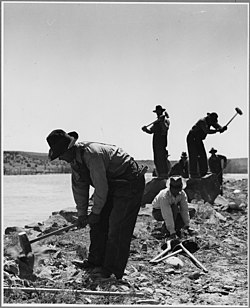
Back تاريخ العمل في الولايات المتحدة Arabic Arbeiterbewegung in den Vereinigten Staaten German Робітничий рух у США Ukrainian
| This article is part of a series on the |
| History of the United States |
|---|
 |
The nature and power of organized labor in the United States is the outcome of historical tensions among counter-acting forces involving workplace rights, wages, working hours, political expression, labor laws, and other working conditions. Organized unions and their umbrella labor federations such as the AFL–CIO and citywide federations have competed, evolved, merged, and split against a backdrop of changing values and priorities, and periodic federal government intervention.
In most industrial nations, the labor movement sponsored its own political parties, with the US as a conspicuous exception. Both major American parties vied for union votes, with the Democratic Party usually much more successful. Labor unions became a central element of the New Deal coalition that dominated national politics from the 1930s into the mid-1960s during the Fifth Party System.[1] Liberal Republicans who supported unions in the Northeast lost power after 1964.[2][3] In recent decades, an enduring alliance was formed between labor unions and the Democrats, whereas the Republican Party has become hostile to unions and collective bargaining rights.[4]
The history of organized labor has been a specialty of scholars since the 1890s, and has produced a large amount of scholarly literature focused on the structure of organized unions. In the 1960s, as social history gained popularity, a new emphasis emerged on the history of workers, including unorganized workers, and with special regard to gender and race. This is called "the new labor history". Much scholarship has attempted to bring the social history perspectives into the study of organized labor.[5]
By most measures, the strength of organized labor has declined in the United States over recent decades.[6]
- ^ Steve Fraser and Gary Gerstle, eds. The Rise and Fall of the New Deal Order, 1930-1980 (1990)
- ^ Archer 2007, p. 1.
- ^ Nicol C. Rae, The Decline and Fall of the Liberal Republicans: From 1952 to the Present (1989)
- ^ Taylor E. Dark (2001). The Unions and the Democrats: An Enduring Alliance. Cornell University Press. ISBN 978-0801487330.
- ^ David Brody, "Reconciling the Old Labor History and the New," Pacific Historical Review 72 (February 1993), 111-126. in JSTOR
- ^ Rosenfeld, Jake (July 30, 2019). "US Labor Studies in the Twenty-First Century: Understanding Laborism Without Labor". Annual Review of Sociology. 45 (1): 449–465. doi:10.1146/annurev-soc-073018-022559. ISSN 0360-0572. S2CID 155227856.